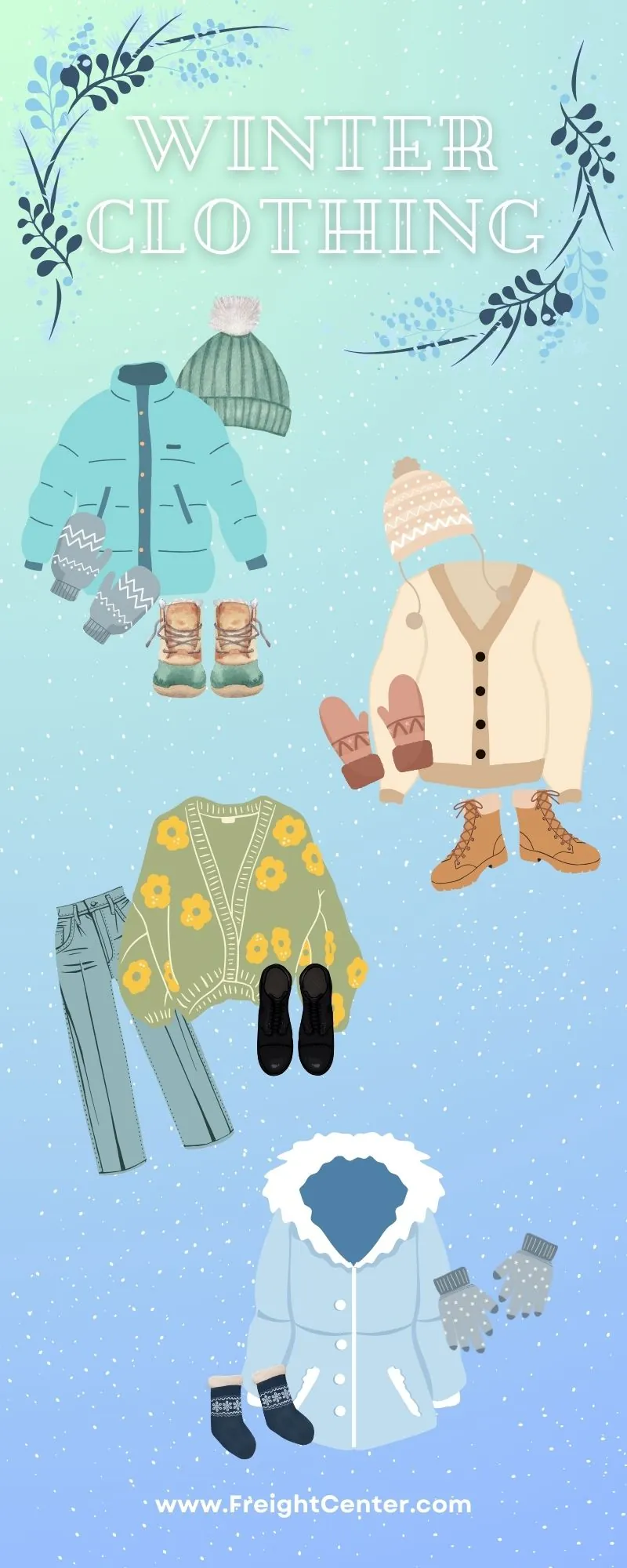
Shipping Winter Clothes with Ease
Winter apparel is a season specific commodity, so as you consider your winter products- be sure to take the many factors of logistics into account before you even begin packing your pallets. This guide will help you make informed decisions on the best practices for shipping winter apparel.
Winter clothes, also known as cold-weather attire or winter wear, are garments specifically designed to provide warmth, protection, and comfort during the colder months of the year. These clothing items are essential for staying cozy and safe in chilly and sometimes harsh winter conditions.
Typical winter clothing includes heavy coats, insulated jackets, sweaters, thermal underwear, scarves, gloves, hats, and insulated boots. These garments are designed to trap body heat, shield against cold winds, and repel moisture, allowing individuals to brave the cold with confidence. Winter clothes come in various styles, materials, and thicknesses to suit different climates, activities, and personal preferences. Whether for fashion or function, winter clothing plays a vital role in keeping us warm and comfortable during the winter season.
Winter is the coldest season of the year, characterized by shorter days, lower temperatures, and often the presence of snow and ice. It typically occurs between December and February in the Northern Hemisphere. Winter brings a distinct change in the environment, with landscapes blanketed in white, frozen lakes, and the need for warm clothing to stay comfortable. It also marks the holiday season, a time for festive celebrations, cozy gatherings by the fireplace, and various winter sports and activities like skiing and ice skating. Winter’s unique charm lies in its capacity to transform the world into a winter wonderland while inviting people to enjoy the beauty and challenges it presents.
Thousands of businesses trust FreightCenter to move their freight faster, smarter, and cheaper! From unbeatable rates to top-notch service, our customers are raving about their shipping success.
See why they keep coming back!
Award-Winning Service, Trusted by Shippers Everywhere!
- 2021, 2017 & 2016 Food Logistics’ Top Green Providers
- 2021 & 2018 Supply & Demand Chain Executives’ Pros to Know: Matthew Brosious
- 2020 & 2019 Top Food Logistics’ 3PL & Cold Storage Provider Award
- 2020 & 2019 Business Observer’s Top 500 Companies on the Gulf Coast
- 2020 & 2017 SmartWay® Transport Partner
- 2020 & 2017 Food Logistics’ Champions: Rock Stars of the Supply Chain
- 2020 Best of Palm Harbor Awards for Local Businesses
- 2017 Green Supply Chain Award from Supply & Demand Chain Executive
- 2017 Tampa Bay Business Journal Heroes at Work
- 2016, 2015, & 2012 Food Logistics Top 100 Software and Technology Providers
- 2013 Tampa Bay Business 100 by Tampa Bay Business Journal
- 2013 Top 100 Great Supply Chain Partners by SupplyChainBrain
- 2012 TIA Samaritan Award Honorable Mention
- 2012, 2011 & 2010 TBBJ Fast 50 Recipient
- 2013, 2011, & 2010 Diversity Business Top Businesses

Choose FreightCenter for Shipping Winter Clothes
- Expertise in Winter Clothing Shipping: FreightCenter boasts extensive experience and proficiency in handling winter clothing shipments. They grasp the unique requirements and challenges of shipping delicate and valuable winter clothing, ensuring proper packaging, handling, and transportation.
- Wide Range of Transportation Options: FreightCenter offers a diverse array of transportation options tailored to your specific winter clothing shipping needs. Whether you require trucking, rail, sea, or air freight, they can provide flexible solutions that accommodate the size, volume, and urgency of your winter clothing shipments.
- Compliance with Safety and Regulatory Standards: FreightCenter excels in navigating transportation regulations and adhering to safety standards. They ensure that your winter clothing shipments comply with relevant regulations, including proper labeling, documentation, and adherence to any specific requirements.
- Insurance Coverage: Recognizing the value of your winter clothing shipments, FreightCenter offers comprehensive insurance options to provide protection and peace of mind. Their insurance coverage helps mitigate risks associated with loss, damage, or unforeseen circumstances during transit.
- Real-time Tracking and Communication: FreightCenter employs advanced tracking technologies that grant real-time visibility into the status of your winter clothing shipments. This enables you to easily monitor the progress of your shipment and receive proactive updates regarding potential delays or issues. Their effective communication channels ensure open lines of communication for swift problem-solving.
Packaging for Winter Clothes
Packaging is a critical aspect of shipping winter clothes, as it plays a pivotal role in safeguarding these valuable and often delicate items from a range of potential hazards during their journey. Here’s an expanded look at the importance of packaging when shipping winter clothing:
- Moisture Protection:
- Moisture is a significant concern when shipping winter clothes, especially in regions prone to rain or snow. To combat this, it’s essential to use packaging materials that provide a reliable barrier against moisture.
- Consider placing the winter clothes in waterproof bags or using plastic wrap to create an additional layer of defense. This prevents rain or snow from seeping into the package and damaging the clothing.
- Cold-Weather Precautions:
- Winter clothes is designed to keep people warm in cold conditions, but during shipping, these items are exposed to varying temperatures. Proper packaging helps mitigate the effects of extreme cold.
- Sturdy boxes or containers should be selected to provide insulation and protection against frigid temperatures. These containers act as a buffer, minimizing exposure to the cold and helping to maintain the clothing’s integrity.
- Protection Against Damage:
- Bulky winter clothes like coats and boots are particularly susceptible to damage during transit. They can get crushed, leading to permanent deformities or tears if not packaged correctly.
- Utilizing sturdy boxes or containers is paramount. Ensure these boxes are of an appropriate size to accommodate the items without excessive pressure. Adding cushioning materials like foam inserts or packing peanuts can further reduce the risk of damage.
- Delicate Item Care:
- Winter clothing often includes delicate items such as scarves, gloves, or intricate knitwear. These items require special attention to prevent wrinkles, tears, or other forms of damage.
- To protect delicate items, wrap them individually in bubble wrap or tissue paper. This protective layer not only shields them from physical harm but also helps maintain their shape and appearance during transit.
In summary, packaging plays a pivotal role in preserving the quality and condition of winter clothes during shipping. It’s crucial to consider the potential challenges posed by moisture, cold temperatures, and the risk of damage. By using appropriate packaging materials, selecting sturdy containers, and providing insulation and protection for delicate items, you can ensure that your winter clothing items reach their destination in the best possible condition, ready to provide warmth and comfort to the recipient.
Climate Considerations: Adapting Your Shipping Approach
Shipping winter clothes requires a nuanced understanding of climate considerations to ensure that the items not only arrive safely but also remain in optimal condition. Here’s an expanded look at how to adapt your shipping approach based on the destination’s climate:
- Cold Regions:
- When sending winter clothes to a cold region, it’s essential to acknowledge the harsh temperatures that these items might encounter during transit.
- Begin by selecting packaging materials that provide superior insulation. Double-check that the packaging seals tightly to prevent cold air from infiltrating. Consider adding an extra layer of insulation, such as thermal bubble wrap, to protect against freezing temperatures.
- In extremely cold areas, it may be advisable to include warming packs or heat-activated pouches within the package. These can help maintain a stable temperature and prevent damage caused by extreme cold.
- Clearly communicate with the recipient about the expected arrival date so they can arrange to retrieve the package promptly. Prolonged exposure to freezing temperatures can be detrimental to winter clothing.
- Warmer Climates:
- When shipping winter clothes to a warmer climate, your focus should shift toward preventing mold or mildew from forming on the items.
- Select packaging that allows for adequate ventilation. Using breathable materials like cotton or mesh bags can help reduce moisture buildup.
- Before sealing the package, ensure that all winter clothing items are thoroughly dry. Any residual moisture can create an environment conducive to mold growth during transit.
- Consider including desiccant packets within the package to absorb any excess moisture that may accumulate during shipping.
- Encourage the recipient to inspect the items upon arrival to ensure they are free from any signs of moisture-related damage. Provide guidance on proper storage, which may involve hanging clothing to allow air circulation.
FreightCenter works year round to ensure the festivities are shipped to you, Whether it be gifts, decorations, or winter clothes- choose FreightCenter to get them to their destination in time for the holidays!
Less-than-truckload shipping is for clients who only need to ship only a few pallets or items to a destination.
Full Truckload shipping refers to transporting goods that occupy an entire trailer, typically involving larger shipments or items that require dedicated space.
A dry van, also known as a box trailer, ships various dry and non-perishable goods.
Air freight transfers and transports goods via a charter or commercial air carrier.


Winter Clothes: Best Packing Practices
Recognizing Vulnerabilities:
- Bulky winter clothing items, owing to their size and weight, are prone to damage during transit. The risk primarily comes from crushing, which can result in permanent deformities or, in the worst cases, tears and irreparable harm.
- Understanding the specific vulnerabilities of each item, such as the fragility of certain fabrics or the susceptibility of zippers and fasteners to pressure, is key to crafting an effective packaging plan.
Selecting the Right Containers:
- Utilizing sturdy boxes or containers is the foundation of damage prevention. Opt for containers made of durable materials that can withstand the rigors of shipping.
- Ensure that the chosen boxes are appropriately sized to accommodate the winter clothing items without subjecting them to excessive pressure. Items should fit snugly without being cramped.
- Avoid using oversized boxes, as they can lead to shifting of the contents during transit, which increases the risk of damage.
Cushioning and Padding:
- The inclusion of cushioning materials is paramount to creating a protective buffer for your winter apparel.
- Consider using foam inserts tailored to the shape and size of each item. These inserts provide structural support and prevent items from shifting within the packaging.
- Packing peanuts or air-filled packing bags can also be used to fill void spaces within the box, further reducing the risk of movement during shipping.
- Pay special attention to delicate areas such as buttons, zippers, and embellishments. Adding extra padding to these vulnerable spots can prevent damage.
Wrapping and Securing:
- Wrap each winter clothing item individually in appropriate protective materials. For example, coats can benefit from garment bags or large plastic sleeves to shield them from dust and moisture.
- Securely fasten any closures, buttons, or zippers to minimize the risk of them snagging on other items.
- Place heavy items like boots at the bottom of the box to provide stability, followed by lighter garments on top. This arrangement helps distribute weight more evenly.
Proper Labeling:
- Clearly label the package as “Fragile” or “Handle with Care” to alert handlers to the delicate nature of the contents.
- Indicate the top of the package, especially if there’s a particular orientation in which items should be kept.
FAQ
Q. How should I package winter clothes for shipping?
When shipping winter clothes, it’s important to use appropriate packaging materials like sturdy boxes, waterproof bags, and insulation to protect them from damage, moisture, and cold temperatures.
Q. What are the considerations for shipping winter clothes internationally?
When shipping winter clothes internationally, be aware of customs regulations, labeling requirements, and potential delays due to weather conditions, especially during the winter season.
Q. How can I ensure my winter clothes arrive in good condition during holiday shipping rush?
To ensure your winter clothes arrive in good condition during the holiday shipping rush, plan early, choose reliable carriers, and consider expedited shipping options if needed.
Q. Is it necessary to insure my winter clothing shipments?
It’s advisable to consider shipping insurance for valuable winter clothing shipments to protect against potential loss, damage, or unforeseen circumstances during transit.

